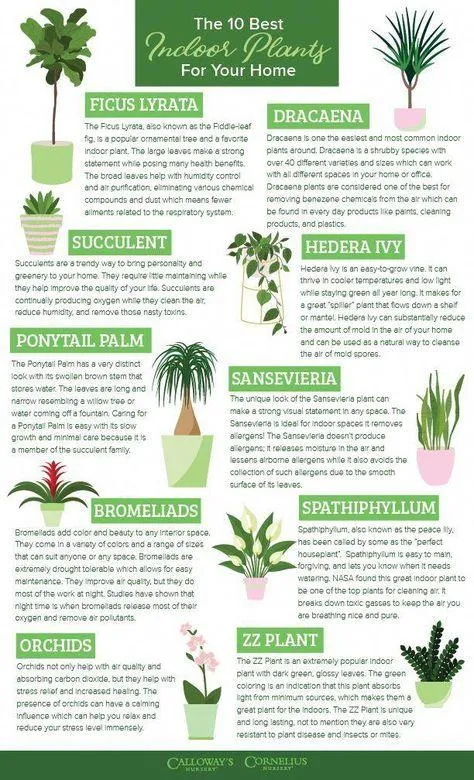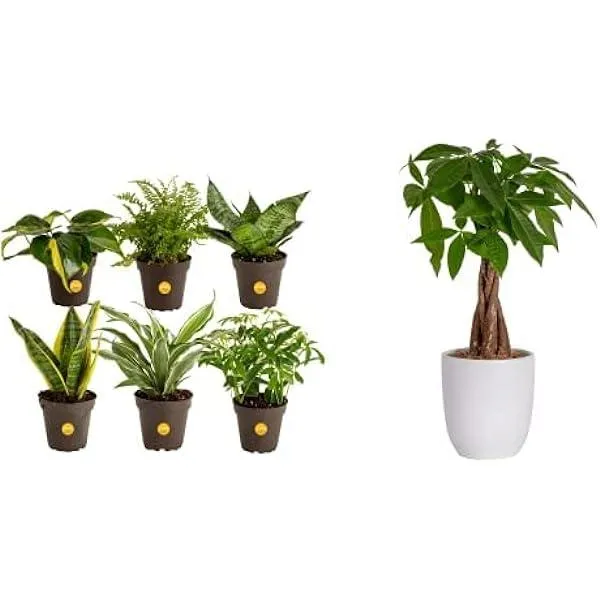The Best Indoor Plants and Trees to Brighten Up Your Home
If you want to fill your home with beautiful greenery but don’t have a backyard, fear not – there are many excellent indoor plant and tree options that will thrive inside. In this article, I’ll go over some of the very best indoor plants to consider, from low-maintenance succulents to elegant potted trees. By the end, you’ll have a good idea of which indoor greens will work well for your space and lifestyle.
Low Light & Low Maintenance Plants
For areas that don’t get a ton of natural light, or if you tend to forget to water your plants, these tough beauties are great choices:
- Snake plant (Sansevieria trifasciata): One of the hardiest houseplants, it can survive months with little water and very low light. Their upright slender green leaves add style to any room.
- Pothos (Epipremnum aureum): A trailing vine that’s nearly impossible to kill. It thrives in low-light areas and the leaves come in various patterns of green, yellow, and white.
- Chinese evergreen (Aglaonema): These have colorful leaves like red, green, or variegated with dark edges. They’re very forgiving of occasional missed waterings.
- ZZ plant (Zamioculcas zamiifolia): With their thick shiny leaves that come in various shades of green, they can go quite a while between waterings.
From my experience, snake plants, pothos, and Chinese evergreens are some of the most resilient indoor plants. I’ve left them for weeks without water and they bounce right back. They make perfect options for low-maintenance plant parents.
Pet-Friendly Plants
If you have cats or dogs, some plants are more hazardous than others if nibbled on. Here are some generally pet-safe picks:
- Peace lily (Spathiphyllum): Their white blooms and broad dark green leaves add beauty. They also help remove toxins from indoor air.
- Spider plant (Chlorophytum comosum): With their trails of baby plants, they’re non-toxic and won’t upset tummies if nibbled.
- Boston fern (Nephrolepis exaltata): A lush spreading fern with cascading fronds that’s considered safe for pets.
- Cast iron plant (Aspidistra elatior): Waxy dark green leaves on sturdy stalks resist nibbles. They gain character with age.
- Ponytail palm (Beaucarnea recurvata): This mini tree-like succulent has twisted trunks topped with whimsical bun-shaped leaves. It’s pet-proof.
I struggled for years treating sick pets that got into toxic plants like lilies or dieffenbachia. Now I stick to known pet-safe varieties with no issues. The plants above are lovely options that won’t endanger furry family members.

High Light Plants
If you have a bright, sun-drenched window, you can grow more demanding tropical plants. Here are some top choices:
- Dracaena marginata: With their upright canes of deep green leaves striped in yellow or white, they bring style to sunny spots.
- Chinese evergreen: As mentioned above, their colorful leaves also thrive in high light.
- Monstera deliciosa: Also called Swiss cheese plant, it’s gaining popularity with big decorative holes in its broad leaves. A classic for showing off.
- Peperomia: These have lots of varieties with different colored glossy foliage such as red, green, or variegated. Great for bright indirect light.
- Philodendron: Huge heart-shaped leaves in varieties like brasil, monstera, or selloum. They vine attractively or climb poles.
I’ve had the best success growing tropical plants by south or west-facing windows. Monstera and philodendron in particular put on huge new leaves all summer when they get lots of sun. You’ll be amazed by how quickly and well they grow with optimal light conditions.
Low Maintenance Trees
For an elegant indoor “tree” that doesn’t take much work, consider:
- Dwarf date palm: With their slender trunks and feathery fronds, they add an exotic Palm Springs vibe. Water every 1-2 weeks.
- Parlor palm: A classic with fanning leaves on a thin upright cane. Water when topsoil is dry to the touch.
- Fiddle leaf fig: Makes a dramatic statement in the corner of a room. Water less in winter when it’s dropping leaves.
- Weeping fig: Arching branches heavy with heart-shaped leaves create a lush curtain effect. Water monthly in winter less often.
- Dwarf umbrella tree: Very small version of a rain tree with rounded leaves on radiating branches. Water every 2-3 weeks, less in winter.
Out of these “trees,” I’ve found fiddle leaf figs to be rather temperamental and drought-sensitive from time to time, requiring a bit more monitoring. But what a look! The others are quite tolerant of average home conditions.
Air-Purifying Plants
For natural indoor air purification, plants with strong filtering abilities include:

- English ivy: Trails beautifully from hanging baskets and has tricolored leaves. Removes formaldehyde, benzene and trichloroethylene.
- Bamboo palm: Its sturdy stalks topped with arching leaves give a tropical vibe. Best for benzene and formaldehyde.
- Chinese evergreen: Its effectiveness lies in absorption rather than metabolic breakdown. Great for formaldehyde, benzene and trichloroethylene.
- Dracaena: Various varieties look lovely and remove volatile organic compounds well. Excellent for benzene and formaldehyde.
- Peace lily: Fast-absorbing toxins and also helps regulate humidity. Top-notch for pollution reduction.
I’ve definitely noticed a fresher indoor air quality when keeping several of these plants around the house, like peace lilies and dracaenas in the living room. They seem to make the air somehow “feel” cleaner, though it’s likely a placebo effect too!
Final Thoughts
I hope this overview of some top indoor plant varieties gave you Ideas for brightening your home naturally. Don’t forget regular care like watering, fertilizing in spring and summer, and repotting as needed. With the right light conditions and locations throughout your space, you can grow gorgeous greens all year long. Have fun choosing your new plants – I’m sure they’ll bring you joy for many years to come!
| Plant | Care Level | Size | Light Needs | Benefits |
|---|---|---|---|---|
| ZZ Plant | Low | Medium | Low | Air purification, easy care |
| Snake Plant | Very Low | Tall | Low | Air purification, drought tolerant |
| Pothos | Low | Vining | Low-Medium | Air purification, fast growing |
| Peace Lily | Low | Medium | Medium | Air purification,INDICATES when to water |
| Chinese Evergreen | Low | Medium-Large | Medium | Green all year, easy care |
FAQ
-
What are some of the best indoor trees to have in a home?
Some of the top indoor trees are the money tree, bamboo palm, and English ivy. The money tree has thick rounded leaves and looks amazing. At the same time, bamboo palms basically don’t need much light to thrive. They’re sort of awesome and low maintenance.English ivy is stunning and great for hanging baskets.
-
What are some of the easiest houseplants to care for?
Pothos, snake plant, and ZZ plant are pretty much the top low-maintenance plants. Pothos can survive with very little light and hardly needs any water. Snake plants are super tough and can go a long time without water. ZZ plants seem to do good no matter what. You could ignore them for weeks! Perhaps spider plants should also get a mention as they’re pretty tough too.
-
How often should indoor plants be watered?
It depends a lot on the type of plant and conditions. Some plants like kind of frequent watering while others can go longer periods without. As a basic rule, check the soil regularly. If the top inch is dry, then it’s time to water. Never let the soil get soaked for too long though. According to experts, it’s better to water thoroughly and then allow the soil to dry out between waterings.

-
What are some low-light houseplants?
The pothos and snake plant were mentioned earlier. Spider plant, philodendron, and shade loving ferns can also do well in low light. However, peace lilies and Chinese evergreens seem to need more brightness. Is that fair to say? Chinese evergreens look simply stunning when happy but maybe don’t do as good in low light. You got to pick plants matching your home’s conditions.
-
Should I fertilize indoor plants?
It really depends. Some plants like the stronger stuff while others are delicate. Houseplants in generally don’t need constant fertilizing though. You can basically get away with using a diluted liquid plant food just during the active growing season, say spring and summer. Maybe do it once a month or so. Some people also claim compost tea works well. But I’d be cautious with anything really strong!
-
What temperature is best for most houseplants?
Most houseplants prefer temperatures between 60 to 80 degrees Fahrenheit. Going much below 60 can hurt more tropical species. At the same time, above 80 degrees may impact some plants. But does the range really matter that much if your home stays within it? Perhaps what’s more important is rapid changes, drafts, and vents blowing right on plants. Steady conditions appear better for indoor plants than big swings.
-
How do I choose pots for indoor plants?
Pots should have drainage holes for excess water to escape. Terracotta is a popular classic choice but can dry soil out fast. Plastic pots work well but some say terra cotta looks better. Personally I think aesthetic is key – pick a pot that complements your plant and décor. And don’t be afraid to get creative with materials like wooden boxes! The right pot can really make a gorgeous plant shine.
-
What’s the best way to deal with pests on houseplants?
Prevention is better than cure, as they say. Check new plants for pests before bringing home. Keep areas clean to avoid infestations. If you do get pests like spider mites or mealybugs, experts recommend isolating the affected plant and washing it with a gentle insecticidal soap. Stronger chemicals should only be a last resort in my view. A lot of times, pests clear up on their own with cleaner conditions.

